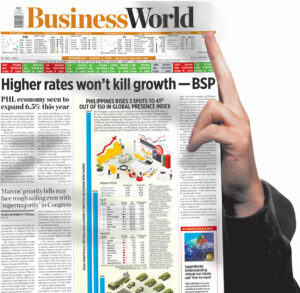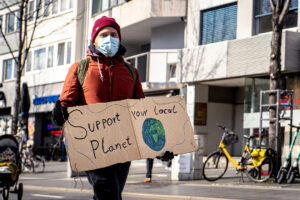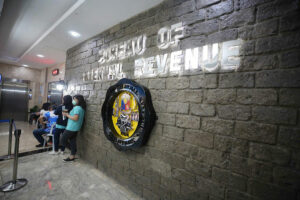In a digital landscape, print remains at BusinessWorld’s core

By Adrian Paul B. Conoza, Special Features Assistant Editor
BusinessWorld has established itself as a daily essential reading for the Philippine business community — from executives, managers, and leaders, right up to entrepreneurs — as well as a good alternative to the usual titles. In every print issue of the paper, one can expect to get a thorough and comprehensive briefing on the latest developments and other information readers need to know and be aware of for the day.
It takes a collective effort within BusinessWorld — from the editorial staff to the people in the sales and marketing department — to bring reports, columns, stories, images, advertisements, and advertorials together and fit them all well within the pages and sections.
“The process of coming out with a newspaper every day is a team effort. You may only see the names of reporters and editors, but there are more people behind the scenes who work to make sure the newspaper comes out every day — the layout artists, proofreaders, researchers, editorial assistants, and graphic artists,” BusinessWorld Managing Editor Cathy Rose A. Garcia shared in an e-mail.
As managing editor, Ms. Garcia assigns stories for reporters to write and submit within the day, while the other editors decide which stories should be prioritized for the front page and which ones go to different sections. “We also make sure that all stories are not just well written but factual and objective,” she added.
Further describing an editor’s work, Alicia A. Herrera, one of the paper’s associate editors, notes that the work even begins before getting into the desk — which in her case includes checking on reporters and looking for leads over breakfast — and sometimes continues after.
Once at the desk, she sifts through e-mail messages, the submitted pieces from reporters and contributors, and relevant stories from the wires — then the main editing work begins.
“Depending on how well a story is written, I may just have to do some minor tweaks, perhaps adding some background. Other times, a full rewrite may be required. I search for photos and illustrations to go with the stories,” continued Ms. Herrera, noting that BusinessWorld editors traditionally did the actual layouts themselves.
On the other hand, Sales and Marketing Director Jay R. Sarmiento is on top of ensuring that advertisements — from the full-page ones to the little ones detailing job openings — and advertorials get published on their respective pages as scheduled.
“Since we are on the advertising side and we sell multimedia advertising platforms, we make sure that everything is in place as far as meeting clients’ requirements and deliverables are concerned. At the same time, we make sure we do an integrated effort on print and digital implementation of ads,” Ms. Sarmiento shared.
Compiling these materials and putting each in the right places require close coordination, as creative director Crecencio I. Cruz explained.
“Laying out a page is like putting up a jigsaw puzzle,” Mr. Cruz said. “You try to fit the articles given. Although you are dealing mostly with text, you have to set the stories appealing enough to catch a reader’s attention,” Mr. Cruz added.
Once much of the materials get arranged, Hilario T. Matundan, production coordinator, handles the placement of ad materials before the entire issue gets printed.
“After the final proofreading of the pages by the proofreaders, I will now need to prepare for the final copy and process it by inserting the ad materials,” Mr. Matundan explained. After checking the page with the ad materials included, I can now send it to the plant via Internet for the printing of the newspaper copies.”
Managing through changes
With the coronavirus pandemic initially causing restrictions, closing the paper was a challenge at the start.
“While most employees were doing work-from-home setup, I was still reporting in the office. I’ve never heard silence that loud before,” Mr. Matundan recalled. “But I took that as a new challenge in my career to strengthen and improve my skills further. I felt that at that moment, the company needed me to be more committed and dedicated.”
For Mr. Cruz, putting up the paper became a little complicated. “The flow of work depends on the working style of the page editor. There are times when putting up a page is like laying it out three times — using the raw articles to check out the length, then the edited version and, finally, the proofread article available online.”
Two years since the pandemic, however, the sudden adjustments have become things the staff already get used to.
“It may have been difficult at first, but BusinessWorld editors have now become used to the new normal. Editing can be done without being physically present at the office,” Ms. Garcia said. “It’s still better, of course, to be at the office so that I can coordinate with people faster and more efficiently.”
Among the editors, Marifi S. Jara, the paper’s Mindanao bureau chief, is likely the one who is most used to working remotely. She observed, nonetheless, that covering stories have been much different than before.
“Having been a remote employee for the last eight years, the work-from-home (WFH) setup prompted by the pandemic was actually an ‘old normal’ for me,” she shared. “But the rise of webinars, online press briefings, and streaming of events made people and other sources of information so much more accessible. It also allowed for broader coverage possibilities across the regions.”
As a reporter, Michelle Anne P. Soliman witnessed this shift in fieldwork firsthand. “During the lockdown, events and conferences were conducted through Zoom. In 2020 to 2021, Zoom events are scheduled within the week. Per day, there were a maximum of three to four events on Zoom,” she shared.
“With the return of physical events early this year, I cover two to three physical events in a day. Some conferences remain online such as pressers for local series, film, and album launches,” she added, noting that fieldwork has gone more hybrid recently.
This shift to hybrid work is something reporter Patricia B. Mirasol shared she very much appreciates, especially that covering on-site events has a distinct edge. “When the pandemic struck, everything literally shifted to the virtual platform,” Ms. Mirasol said. “Zoom is super great, but nothing beats the energy of physical interactions.”
Editor Victor V. Saulon observed, however, that recent situations have made it harder for reporters to do ambush or chance interviews since in-person events and press conferences are still limited. “Now, sources can choose to ignore you when you text, send an email or call. But it’s easier in a way because you don’t have to suffer Metro Manila traffic, for now,” he added.
For Josielyn Luna-Manuel, the paper’s special features editor, remote work has shown many advantages.
“For special features and advertorials, most of our coverages or interviews with our sources are now done virtually or through e-mail compared to pre-pandemic days when writers usually need to attend physical events or do personal interviews with executives,” Ms. Manuel explained. “The whole process of producing content — from client briefings to interviews, writing and editing, layouting, and securing approvals — has been less time-consuming and more efficient now.”
In sum, amid the said challenges and perks, putting up a newspaper has surely gone paperless, as Ms. Herrera noted. In fact, the late Raul L. Locsin, BusinessWorld’s founder, predicted this beforehand.
“Mr. Locsin had said decades ago that with e-mail and with wires accessible via terminals (rather than the old teletype-style machines with their huge rolls of paper) we would stop using paper in the office,” Ms. Herrera shared. “This never really happened until the COVID lockdowns. Press releases are now sent to us via e-mail — no more stacks of envelopes to sort through in the morning. This is a welcome change as it is now a matter of cut-and-paste then editing rather than having to type up the release ourselves.”
Motivations
Amid all these changes, nonetheless, a dedication to continue to serve the purpose of BusinessWorld, which also translates to a commitment to excellence, remains a driving force for the people behind the paper.
“We believe in the mission of BusinessWorld. We love our readers and clients, and we have employees and their respective families to take care of. Those are more than enough inspiration for us to do our role in closing the paper despite the challenges,” Ms. Sarmiento shared.
For Ms. Jara, what keeps her motivated is the fact that BusinessWorld gives a platform “to somehow contribute to nation-building, particularly in terms of highlighting growth potential and opportunities outside the capital region.”
For Ms. Manuel, in spite of work-related and personal challenges brought by the pandemic, keeping in mind the impact that their team’s work could bring serves as an inspiration.
“Knowing that our work today makes an impact tomorrow — both for the company and the public it serves — no efforts are wasted. We only get stronger, more skilled, and prouder to be part of something bigger than ourselves,” Ms. Manuel said.
For others, it is more about experiencing the joy in the work they do, as well as in seeing the finished product.
“I consider the fieldwork I do as a life bucket list,” Ms. Soliman said. “It’s been an enriching experience to be in a room with, and to interview or converse with young and established people in arts, culture, and entertainment.”
“It is also a privilege to see and watch their body of work and listen to them talk about their craft. There is also a lot to learn of our history and culture when traveling to provinces, and other cultures from abroad,” she added.
“Working on a newspaper for more than two decades and seeing your work on the following day in print and online is enough [motivation],” Graphic Artist Bong R. Fortin said. “Stress is always a part of it. Finishing everything and pushing your work before the off stone is the challenge.”
Family and loved ones also serve as an inspiration, nonetheless.
“I always tell myself that I have to do my best in my job no matter what as if this will be my first and last job, by God’s will. But if there are moments when it is really difficult or stressful, I always think of my family. I am happily married with five children, who are all my inspiration to continue striving in life,” Mr. Matundan shared.
A medium to stay
The past years saw BusinessWorld fulfilling its purpose through new means, particularly on-the-ground and digital platforms. Yet, even in these times when people often turn to screens for information and diversion, a newspaper that can be held and flipped through still remains a useful and indispensable medium.
Aside from providing a public record of history, Ms. Garcia stressed, newspapers like BusinessWorld have an important role in highlighting deep, insightful stories over “clickbait” news flooding social media.
“For me, there’s still nothing like the look, feel, and even the smell of the printed newspaper,” she added. “Flipping through the pages of the paper, you can find stories that you would never see on your Facebook timeline but are more important than the latest celebrity news.”
A physical paper is even still preferred at present, even among the paper’s target audience. “Many of the business sources that we have talked to are now physically back in the office. They still look for a printed newspaper when in the workplace,” Mr. Saulon shared.
Print also has a distinct way of presenting information and catching and keeping attention — which seems to be a hard thing to get nowadays.
“I think that because the editorial choices are made by people, you see a greater variety of topics on paper than you would online. You flip a page and find yourself engaged by a headline that would never have been presented to you online,” Ms. Herrera said. “The world expands in print; because of the algorithms, it shrinks online.”
“I think printed newspaper, like a traditional book, has a power of forcing the reader to fully focus on that thing on hand, which probably means better knowledge absorption, understanding, and critical thinking,” Ms. Jara said. “And there is joy in holding, reading that paper — something that perhaps needs to be discovered by the digital generation.”




